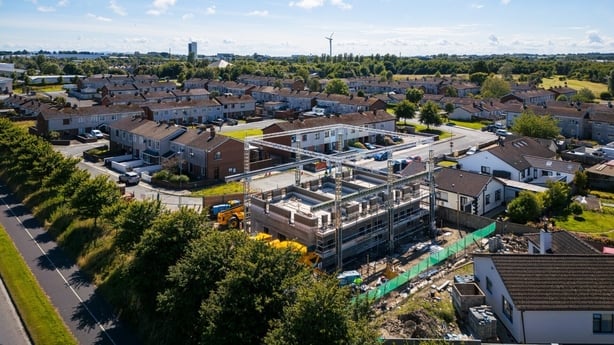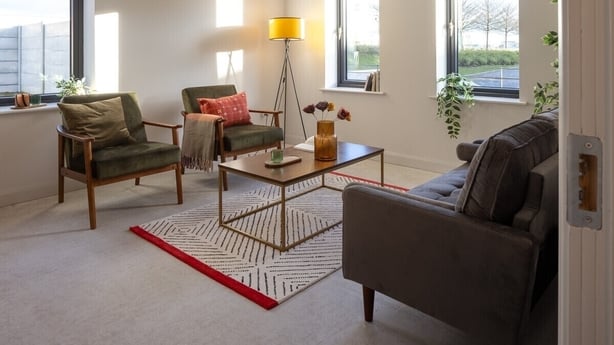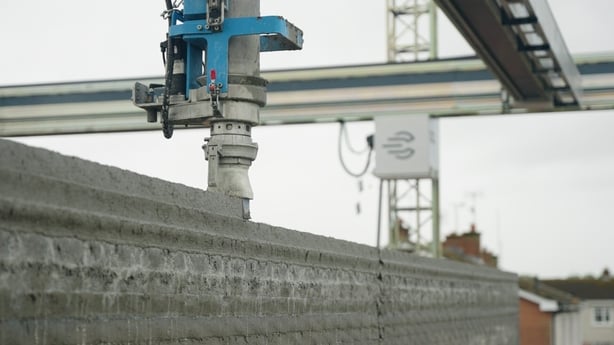Three families in Dundalk, Co Louth, are becoming the first residents in Ireland and the UK to live in 3D printed houses.
The two-storey, three-bedroom terraced houses were built using construction printing technology that automates the concrete laying process.
An official event was held in Dundalk to formally hand the homes in Grange Close over to the three local families, who were previously on the Louth County Council social housing list.
The construction of the houses involved the installation of a 3D concrete printer on a gantry, which was programmed to pipe out concrete as per a digital plan. The cavity walls were built from scratch, without using concrete blocks.

The three houses were built over the course of six months between last May and November.
Developers have said that the COBOD 3D construction printing technology used in the project automates the concrete laying process, resulting in time and cost savings, improved structural integrity, and the more efficient use of resources.
The housing development at Grange Close in Dundalk was the result of a partnership between Louth County Council and Irish construction technology company Harcourt Technologies (HTL), as well as construction firm Roadstone, the Louth & Meath Education & Training Board (LMETB) and Harcourt Architects.

Each of the three houses has a gross internal area of 110 square metres and an A2 energy rating.
(Watch above: Dundalk homes being built - filmed July 2024)
Read more:
Ireland's first 3D printed homes being built in Dundalk
3D printing technology used for Louth housing project
The printed structures were achieved in 12 print days, with a total machine on-site time of 18 working days.
HTL has said that this is 60% faster than the traditional 44-day concrete block method and the total working days for the project amounted to 132, achieving a 35% savings compared to the 203 days required for traditional construction.
In monetary terms, the company said the construction cost of each home was around €253,000 excluding VAT and this equates to existing traditional construction costs.
Managing Director of HTL Justin Kinsella said the project is an example of how such technology can transform housing delivery.
In a statement, he said: "At Harcourt Technologies we have successfully demonstrated the benefits of the technology in delivering a traditional and trusted concrete cavity wall construction, with remarkable efficiency - 60% faster than conventional methods and reducing the overall project delivery by 35%.

"Thanks to our partnership with Roadstone, we're now positioned to scale up this solution across Ireland and help contribute to the much-needed supply of cost-effective, and sustainable housing throughout the country."
The success of the Grange Close project has also been attributed to the involvement of the LMETB, which provided training and upskilling to workers in 3D construction printing technology.
Chief Executive of the LMETB and the Advanced Training and Manufacturing Centre of Excellence, Martin O'Brien, said: "The Grange Close project is a testament to what can be achieved when forward-thinking ideas and collaborative efforts come together.
"We are proud to play a central role in delivering Ireland’s first 3D printed homes, which will provide much-needed social housing to families in Louth," he added.
Meanwhile, Louth County Council CEO David Conway said the project could only have been achieved by all of the organisations involved working together.
"The quality of the units and the impressive build duration are a testament to the successful collaboration between Louth County Council, HTL.tech, the LMETB, Roadstone Ltd and Harcourt Architects.
"The provision of high-quality, sustainable housing remains a key objective for Louth County Council, and this project demonstrates how innovation and partnership can help us achieve that goal."
Councillor Kevin Callan, Cathaoirleach of Louth County Council, also stressed the importance of housing delivery for the local authority.
"This is a landmark day for Co Louth. Our local authority continues to lead the way in housing development, surpassing targets and delivering homes through innovation.
"I have no doubt this project will serve as a model for similar initiatives across the country. I extend my gratitude to all involved, particularly our housing section, management team, and the housing directorate.
"At a time of increasing housing demand, we are making real progress, further solidifying Louth's reputation as a prime location to live, work, and thrive," he concluded.
We need your consent to load this rte-player contentWe use rte-player to manage extra content that can set cookies on your device and collect data about your activity. Please review their details and accept them to load the content.Manage Preferences







